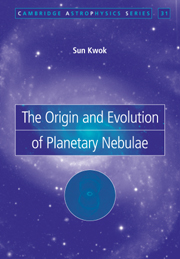Book contents
- Frontmatter
- Contents
- Preface
- 1 History and overview
- 2 Ionization structure of planetary nebulae
- 3 Nebular line radiation
- 4 Nebular continuum radiation
- 5 The neutral gas component
- 6 The dust component
- 7 Observations of the central star of planetary nebulae
- 8 Morphologies of planetary nebulae
- 9 Problems and questions
- 10 Asymptotic giant branch stars – progenitors of planetary nebulae
- 11 Evolution of the central stars
- 12 Formation of planetary nebulae
- 13 Dynamical evolution of planetary nebulae
- 14 Protoplanetary nebulae – the transition objects
- 15 Evolution to the white dwarf stage
- 16 Distances to planetary nebulae
- 17 Comparison between evolutionary models and observations
- 18 PN in the galactic context
- 19 Chemical abundances
- 20 Planetary nebulae in other galaxies
- 21 Concluding remarks
- References
- Appendix List of symbols and abbreviations
- Subject index
19 - Chemical abundances
Published online by Cambridge University Press: 04 November 2009
- Frontmatter
- Contents
- Preface
- 1 History and overview
- 2 Ionization structure of planetary nebulae
- 3 Nebular line radiation
- 4 Nebular continuum radiation
- 5 The neutral gas component
- 6 The dust component
- 7 Observations of the central star of planetary nebulae
- 8 Morphologies of planetary nebulae
- 9 Problems and questions
- 10 Asymptotic giant branch stars – progenitors of planetary nebulae
- 11 Evolution of the central stars
- 12 Formation of planetary nebulae
- 13 Dynamical evolution of planetary nebulae
- 14 Protoplanetary nebulae – the transition objects
- 15 Evolution to the white dwarf stage
- 16 Distances to planetary nebulae
- 17 Comparison between evolutionary models and observations
- 18 PN in the galactic context
- 19 Chemical abundances
- 20 Planetary nebulae in other galaxies
- 21 Concluding remarks
- References
- Appendix List of symbols and abbreviations
- Subject index
Summary
Progenitors of PN play an important role in the chemical enrichment of the Galaxy because He and significant amounts of C and N are produced by nucleosynthesis during the MS, RG, and AGB stages of their evolution. These elements are brought to the surface of the star by convection events called dredge ups (Iben, 1991). The first dredge up occurs in all stars on the RGB following the exhaustion of H in the core. Convection extending into the interior brings material processed in the CNO cycle to the surface. The second dredge-up occurs only in higher mass (≥3 M⊙) stars during the early AGB phase and results in an increase in the surface abundance of 4 He and 14 N at the expense of 12 C and 16 O. The third dredge-up occurs on the AGB after each He-shell flash, resulting in He, C, and s-process elements being brought to the surface (Renzini and Voli, 1981). This repeated enhancement of C abundance in the stellar surface may in some stars bring the C/O ratio to be greater than unity. Since the less abundant of these two elements is completely tied up in the CO molecule, the photospheric spectrum of the star will change from O-based (e.g., TiO and VO) to C-based (e.g., C2 and CN), and a carbon star is created (see Section 10.2). Stellar winds during the AGB eject these elements from the stellar surface and therefore enrich the interstellar medium.
- Type
- Chapter
- Information
- The Origin and Evolution of Planetary Nebulae , pp. 199 - 207Publisher: Cambridge University PressPrint publication year: 2000
- 5
- Cited by

